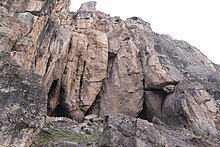Areni-1
Areni-1 (also Armenian T'rchunneri , bird cave ' called) of Noravank is a karst cave near the city of Yeghegnadzor in südarmenischen Province Vayots Dzor Province . The cave was inhabited at least from the Stone Age to the Copper Age and was also used as a place of worship. It may also have been used in the Middle Ages. This is indicated by traces in the cave. The cave was discovered in the 1970s and has been systematically explored since 2007.
Location and description
The bird cave is located above the left bank of the Arpa River at the southern end of the Little Caucasus about 110 kilometers from Yerevan, the Armenian capital. In the immediate vicinity of the cave, the river valley opens into a small fertile valley in which wine and fruit are grown to this day. The cave itself consists of three chambers, the first two of which are connected by passages. In total, it is about 40 meters deep and 500 square meters in size. During excavations, the remains of a defensive wall that protected the entrance to the cave were discovered. Your year of construction is unclear. It could not have been built until the Middle Ages. There are signs of human presence in the cave for the 13th and 14th centuries.
The first chamber probably served as living space and as a goat barn. This is indicated by the remains of dwellings built into the cave, tamped floors and well sockets. There are numerous small side chambers and niches on the walls. The microclimate of the cave is well suited for food storage and is also responsible for the good state of preservation of the artifacts found in the cave. In the rear area of the cave there were also storage pots of different sizes and shapes in which grapes, plums, apricots, wheat and oats were stored. Based on the radiocarbon method, the oldest artifacts found in the chamber (bone fragments, charcoal, tissue pieces, seeds and other organic residues) are dated to the end of the 5th or the beginning of the 4th millennium BC.
The second chamber probably served as a cult site. Two skulls of young women were discovered there, buried in clay pots. The archaeologists assume that fertility rituals were most likely performed there.
Areni-1 is one of the few and best-preserved Copper Age monuments in the South Caucasus and is one of the most important archaeological sites. In the cave, archaeologists found well-preserved remains of plants and fruits that allow accurate dating. They prove that the former inhabitants of the cave used a wide variety of domesticated and wild plants. The oldest wine press in the world (around 3000 BC) found in the cave documents the almost 6000-year history of wine production in Armenia. The traces of winemaking in the cave date from the late Copper Age, when the cave was used for complex burial rituals and probably human sacrifices were also performed. A footwear found in the cave and more than 5,500 years old is considered the oldest leather shoe in the world and the more than 5,900 year old women's skirt (3900 BC) made of woven straw, discovered in 2010, is also the oldest example to date.
Web links
Individual evidence
- ^ A b c d Metheny, Karen Bescherer, 1960-, Beaudry, Mary Carolyn, 1950-: Archeology of food: an encyclopedia . Lanham 2015, ISBN 978-0-7591-2366-3 , pp. 40 ( limited preview in Google Book search).
- ^ A b c d Helix Consulting LLC: Noravank-Birds Cave: T'rchunneri (Birds) Cave (Areni 1) - Noravank-Birds Cave - Armenian Heritage. Retrieved November 29, 2017 .
- ^ Areni-1 Cave, Armenia: A Chalcolithic - Early Bronze Age settlement and ritual site in the southern Caucasus (PDF Download Available). Retrieved November 29, 2017 .
- ^ Earliest Known Winery Found in Armenian Cave . January 12, 2011 ( nationalgeographic.com [accessed November 29, 2017]).
- ↑ 5,900-year-old women's skirt discovered in Armenian cave. Retrieved November 29, 2017 .
Coordinates: 39 ° 43 ′ 53 ″ N , 45 ° 12 ′ 13 ″ E



